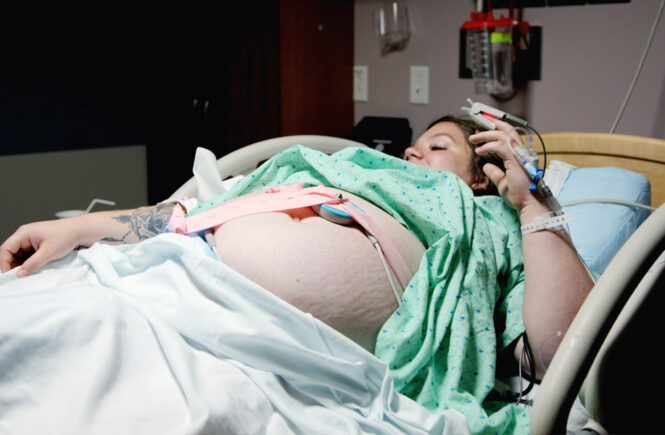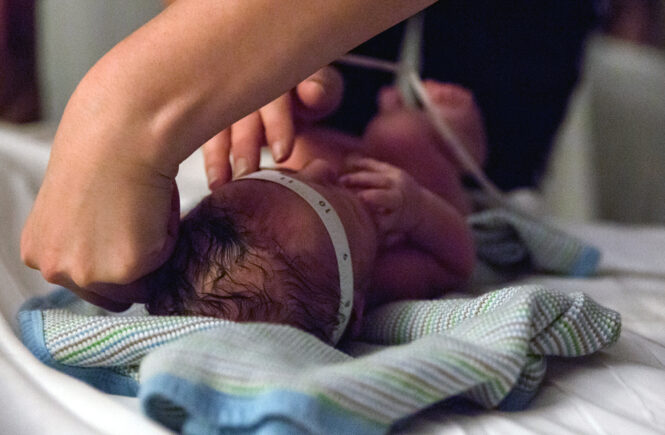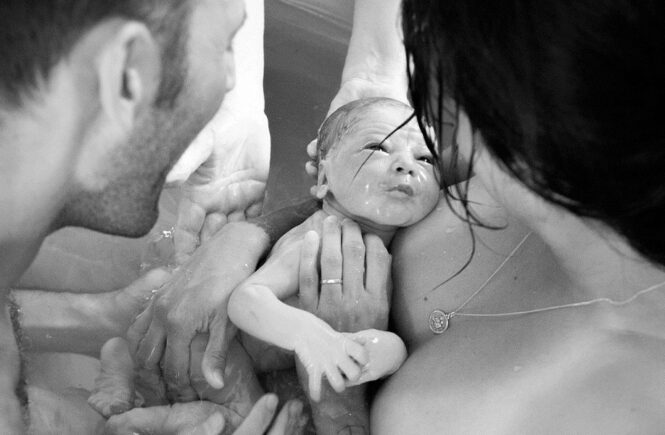At some point in your pregnancy journey, you’ll come across the term cascade of birth interventions. This common phrase describes how one intervention during birth can lead to another until the process spins out of control. What starts as a small intervention to help mom feel more relaxed, or to help the baby through the birth process, ends with multiple scenarios that may be overwhelming for mom and baby. These escalating interventions can lead to an outcome that no one desired in the beginning, especially mom.
An Example of the Cascade of Birth Interventions
Let’s say a new mom has started her labor. She couldn’t be happier that her big day has finally arrived. She is nervous and a little apprehensive, but also excited to see her new baby. She arrives at the hospital with her birth partner and speaks with someone at admissions. After they fill out some paperwork, they are guided into a room to receive a standard vaginal exam. The care provider finds mom to be only a few centimeters dilated with slowing contractions of five to seven minutes apart. However, because mom is six days past her due date, she is admitted.
Now that mom is officially a patient of record at the hospital, she receives a saline IV solution to keep her hydrated purely due to hospital regulations. The IV also helps keep the veins open in case more fluid is needed later during the birth process. Mom is hooked up to a fetal heart rate monitor and a contraction monitor so that everyone can track her progress. Because mom has been attached to machines and given an IV, she is confined to bed, also per hospital regulation. You can already see that things are starting to spiral. After some time passes and no change occurs, drugs are introduced and an epidural is requested because of the pain. Some of this pain is directly a result of mom being restricted to laying on her back for so long. We are now well outside of mom’s desired birth plan. More and more interventions are introduced until the possibility of a c-section is floated by the care provider.

This story describes a scenario that may occur. With any birth, there are a lot of things that can happen that no one anticipated. Mom and her birth partner do their best to stick to their birth plan, and hopefully, the care providers and chosen setting do their best to honor those wishes. The problem is that the standard practice at most major facilities results in an abundance of caution that leads to a cascade of birth interventions. This can be overwhelming for any mom that doesn’t feel prepared to manage the new information in the middle of trying to give birth.
Describing these birth interventions isn’t an attempt to place blame on the hospital, or their staff. They are operating as they see fit according to their guidelines. It is also essential to keep in mind that the cascade of birth interventions isn’t a linear line. One response doesn’t immediately lead to another intervention. What it demonstrates is that this slope can be slippery, and the control of the situation can quickly be out of mom’s hands. The fact is that a lot of healthcare providers in the U.S. will utilize practices that can lead to a cascade of interventions. Understanding what those practices are is a great way to prepare yourself for what may occur.
Standard Practices that Lead to a Cascade of Birth Interventions
- Using various medications to induce labor
- Artificially breaking the membranes surrounding the baby and releasing amniotic fluid before or during labor
- Using synthetic oxytocin medicine like Pitocin to make labor move faster
- Giving medications for pain relief
- Laboring in bed versus being upright and moving about
All these practices can lead to severe issues for mom and baby. They could cause undesirable effects on your baby, making it harder to push or open opportunities for infection during the birth process. No one means to harm you or your baby intentionally, but there are some things you can do to prevent a cascade of interventions.
How to Prevent a Cascade of Birth Interventions
- Choose a care provider at a birth setting that has a proven low rate of interventions
- Become familiar with the best research concerning interventions
- Take a childbirth education class
- Get to know the community around your healthcare provider and choice of setting for your birth
- Have an open and respectful conversation with your care provider about why you may need any interventions
- Make your birth plan known to everyone on the team and especially our birth partner or doula
- Talk to your care provider about options like “watchful waiting” or using less invasive alternatives to common interventions
- Hire a doula
- Know that you have the right to accept or refuse procedures, drugs, tests, and treatments
It has become more common in the U.S. for women giving birth to receive a c-section. This rate increase is due to many reasons involving time, insurance, doctor preference, and public stigma. We must realize that c-sections are an invasive surgery that should only occur in the event of a medical issue. The goal for any mom that is seeking a natural birth is to take control of her birth experience. She can achieve this goal through many of the options listed to help her avoid a cascade of birth interventions.
Giving birth should be a beautiful experience. It is common to have some challenges along the way, but that doesn’t mean you should feel any less empowered to overcome those difficulties. Your voice is important and should be respected by everyone involved in the birth process. Do you know of any other attributes about a cascade of interventions that we didn’t mention? Please feel free to send an email on the contact page.




